VSEL/Telepresence home page
Virtual Space Exploration Lab
and related Telepresence projects
This page is under construction.
Please excuse the dust and debris.
The Center for Design Research (CDR)
at Stanford University
has a primary focus of studying the design process and methods in
practice.
Having an excellent collection of engineers from
many disciplines, CDR often generates ideas for potentially
"fixing" problems that are observed.
A well documented
problem observed in design processes is the awkward interface
between designers and machines.
These machines may be mechanical (robots) or electronic (computers).
This group of projects employs
telepresence technologies
in its exploration of human-machine interaction.
The Virtual Space Exploration Lab (VSEL) represents a subset of these projects
that inter-relate through both collaboration or shared technologies.
Contents
Telepresence projects at CDR
Projects related to the Virtual Space Exploration Lab are marked.
(In chronological order of their starting dates)
-
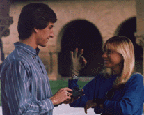 TalkingGlove (VSEL)
TalkingGlove (VSEL)
- (J. F. Kramer & L. Leifer) -
an assistive communication device for non-speaking deaf individuals,
which recognizes American Sign Language (ASL) finger-spelling
to generate text or synthesized speech.
Core to the TalkingGlove system is an instrumented glove
and neural-net algorithm for mapping dynamic hand formations
into a digital command stream.
A CDR spinoff enterprise, Virtual
Technologies, developed the patented technology into the
Virtex CyberGlove (TM) hand instrumentation system.
-
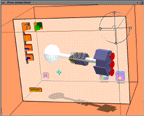 (108k)
CutPlane (VSEL)
(108k)
CutPlane (VSEL)
- (L. J. Edwards, W. A. Kessler, & L. Leifer) -
a solid-modeling interaction metaphor for a standard workstation,
displacing the need for orthonormal projections, command line input, and
menu command selection, with of continuous 3D access.
A CDR spinoff enterprise, Beyond Technologies, developed and implemented
the CutPlane interface in conceptual design tool product called
3Form, which further included the concept of 3D tools to represent
commands that the operator could select and apply to a 3D object in a
particular location, orientation, and manner.
-
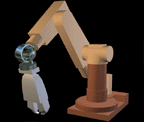 RoboGlyph
RoboGlyph
- (D. Lees & L. Leifer) -
a visual language for controlling and programming robots,
RoboGlyph was created to simplify the programming of manipulation tasks
for a service robot for quadriplegics.
It was designed to take advantage of the presence of the user/programmer
and facilitate his or her operation of the robot
with graphical representations of the robot's configurations and motions.
Also, force-sensing is used to detect and control interactions
with the environment,
so the user is not responsible for fine-positioning tasks.
Experiments with RoboGlyph have shown that,
after only one or two hours of training,
computer literate health care professionals with no robotics experience
can write working robot programs as quickly as expert robot programmers.
Expert programmers who use RoboGlyph can program
at least as fast as they can with textual robot programming languages,
after only one hour of training.
The programs written by all RoboGlyph users
(sample storyboard)
were much easier to read
and maintain than similar programs written in textual languages.
An
abstract and
report (5.5MB) have been published in Proceedings of
1993 IEEE International Conference on Robotics and Automation:
A Graphical Programming Language for Robots Operating in
Lightly Structured Environments,
Atlanta, GA, 2-6 May 1993.
-
 VirtualHand (VSEL)
VirtualHand (VSEL)
- (W. L. Chapin & J. F. Kramer) -
a dynamic simulated, anthropometrically correct, hand model
driven by an instrumented glove for computational recreation of
the operator's dexterity.
The project reached the goal to reconstruct a 3D model of a live
human hand for the purpose of visual display or computational
dexterous interaction with other 3D models.
The interframe data required to dynamically drive the virtual hand
was less than 34 bytes, a packet size compatible with standard telephone
equipment at 30 Hz, independent of the visual quality of the display.
-
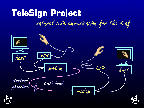 (57k)
TeleSign (VSEL)
(57k)
TeleSign (VSEL)
- (W. Chapin, C. Haas, J. Kramer, L. Leifer, & E. Macken) -
a collaborative design effort between CDR and
the Center for the Study of Language and Information,
leveraged from the TalkingGlove and VirtualHand projects to develop
a system for visual expression and manual communication.
The TeleSign system empowers two remote individuals to communicate
visible gestures through a shared virtual environment
across standard low-bandwidth telephone channels.
-
Conformal Mapping
- (L. J. Edwards) -
a new method for achieving interactive deformations of free-form
surfaces in the design of geometric shapes.
The method requires minimal user input, and
allows direct manipulation of any point on the surface.
Surface
deformations can be highly localized or extend over a large area.
Unlike traditional methods providing local control, deformations over
an extended area do not require manipulation of a large number of
control points.
The method allows very concise
definition of free-form surfaces with minimal storage requirements,
and manipulation of surface patch interiors is, computationally, very
inexpensive.
Abstract
-
Virtual Fixtures
as Perceptual Tools for Telepresence Tasks:
- (L. Rosenberg & L. Leifer) -
an application of virtual reality technologies
intended to enhance human performance in telepresence tasks by
introducing abstract perceptual information into the human-
machine interface.
This work explores the design and
implementation of computer generated entities know as Virtual
Fixtures composed of visual, haptic, and auditory sensations.
Such fixtures are overlaid on top of the sensory feedback from a
remote telepresence worksite and serve as perceptual aids for
task performance.
This work centers around the development of
a design principle known as Design for Perception which
provides a basic methodology for efficiently generating and
presenting virtual percepts using perceptual rather than
physical parameters.
This work is sponsored in part by:
USAF Armstrong Laboratory: Human Sensory Feedback Group
and
NASA Ames Research Center,
human factors group.
-
 VirtualGrasp (VSEL)
VirtualGrasp (VSEL)
- (W. L. Chapin, J. F. Kramer, & L. Leifer) -
an extension of the VirtualHand model to enable force closure
and contact control of 3D virtual objects for dexterous manipulation.
The project is the virtual parallel to the CDR project on
Dynamic Tactile Sensing and Dexterous Manipulation
by Chang, Hyde, and Tremblay, led by Prof. Mark Cutkosky.
-
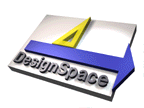 DesignSpace (VSEL)
DesignSpace (VSEL)
- (W. L. Chapin, T. A. Lacey, & L. Leifer) -
The integration of VSEL projects to form a conceptual application
with these technologies for collaborative design.
Past and Present VSEL staff and CDR Telepresence group members
-
-
William L. Chapin
chapin@cdr.stanford.edu-
Laurence J. Edwards
edwards@cdr.stanford.edu-
Timothy A. Lacey
lacey@cdr.stanford.edu- David Lees
lees@cdr.stanford.edu-
Larry Leifer, PhD.
leifer@cdr.stanford.edu- William A. Kessler
kessler@cdr.stanford.edu-
James F. Kramer
kramer@cdr.stanford.edu- Louis Rosenberg
rosenberg@cdr.stanford.edu- Toni W. Schneider
toni@cre.com
Similar work found on the web:
-
The CAVE at UIC's EVL.
- A comment wrt VSEL is being prepared.
-
NCSA's Virtual Reality Project.
- A comment wrt VSEL is being prepared.
-
TUDelft's Virtual Environment Projects in the Netherlands.
- A comment wrt VSEL is being prepared.
- If you know of similar labs or projects with home pages on the web,
please send us the URL via email.
_______________________________________________ 

 ______
______
chapin@cdr.stanford.edu
last update - 9 Mar 94
 TalkingGlove (VSEL)
TalkingGlove (VSEL)
 (108k)
CutPlane (VSEL)
(108k)
CutPlane (VSEL)
 RoboGlyph
RoboGlyph
 VirtualHand (VSEL)
VirtualHand (VSEL)
 (57k)
TeleSign (VSEL)
(57k)
TeleSign (VSEL)
 VirtualGrasp (VSEL)
VirtualGrasp (VSEL)
 DesignSpace (VSEL)
DesignSpace (VSEL)